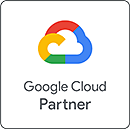Data Engineering


Description
Get hands-on experience with designing and building data processing systems on
Google Cloud. This course uses lectures, demos, and hands-on labs to show you how
to design data processing systems, build end-to-end data pipelines, analyze data,
and implement machine learning. This course covers structured, unstructured, and
streaming data.
Intended audience
This class is intended for developers who are responsible for: Extracting, loading, transforming, cleaning, and validating data.
Designing pipelines and architectures for data processing.
Integrating analytics and machine learning capabilities into data pipelines.
Querying datasets, visualizing query results, and creating reports.
▼Expand All
-
Introduction to Data Engineering
-
Explore the role of a data engineer
-
Analyze data engineering challenges
-
Introduction to BigQuery
-
Data lakes and data warehouses
-
Transactional databases versus data warehouses
-
Partner effectively with other data teams
-
Manage data access and governance
-
Build production-ready pipelines
-
Review Google Cloud customer case study
-
-
Building a Data Lake
-
Introduction to data lakes
-
Data storage and ETL options on Google Cloud
-
Building a data lake using Cloud Storage
-
Securing Cloud Storage
-
Storing all sorts of data types
-
Cloud SQL as a relational data lake
-
-
Building a Data Warehouse
-
The modern data warehouse
-
Introduction to BigQuery
-
Getting started with BigQuery
-
Loading data
-
Exploring schemas
-
Schema design
-
Nested and repeated fields
-
Optimizing with partitioning and clustering
-
-
Introduction to Building Batch Data Pipelines
-
EL, ELT, ETL
-
Quality considerations
-
How to carry out operations in BigQuery
-
Shortcomings
-
ETL to solve data quality issues
-
-
Executing Spark on Dataproc
-
The Hadoop ecosystem
-
Run Hadoop on Dataproc
-
Cloud Storage instead of HDFS
-
Optimize Dataproc
-
-
Serverless Data Processing with Dataflow
-
Introduction to Dataflow
-
Why customers value Dataflow
-
Dataflow pipelines
-
Aggregating with GroupByKey and Combine
-
Side inputs and windows
-
Dataflow templates
-
Dataflow SQL
-
-
Manage Data Pipelines with Cloud Data Fusion and Cloud Composer
-
Building batch data pipelines visually with Cloud Data Fusion
-
Components
-
UI overview
-
Building a pipeline
-
Exploring data using Wrangler
-
Orchestrating work between Google Cloud services with Cloud Composer
-
Apache Airflow environment
-
DAGs and operators
-
Workflow scheduling
-
Monitoring and logging
-
-
Introduction to Processing Streaming Data
-
Process Streaming Data
-
-
Serverless Messaging with Pub/Sub
-
Introduction to Pub/Sub
-
Pub/Sub push versus pull
-
Publishing with Pub/Sub code
-
-
Dataflow Streaming Features
-
Steaming data challenges
-
Dataflow windowing
-
-
High-Throughput BigQuery and Bigtable Streaming Features
-
Streaming into BigQuery and visualizing results
-
High-throughput streaming with Cloud Bigtable
-
Optimizing Cloud Bigtable performance
-
-
Advanced BigQuery Functionality and Performance
-
Analytic window functions
-
Use With clauses
-
GIS functions
-
Performance considerations
-
-
Introduction to Analytics and AI
-
What is AI?
-
From ad-hoc data analysis to data-driven decisions
-
Options for ML models on Google Cloud
-
-
Prebuilt ML Model APIs for Unstructured Data
-
Unstructured data is hard
-
ML APIs for enriching data
-
-
Big Data Analytics with Notebooks
-
What’s a notebook?
-
BigQuery magic and ties to Pandas
-
-
Production ML Pipelines
-
Ways to do ML on Google Cloud
-
Vertex AI Pipelines
-
AI Hub
-
-
Custom Model Building with SQL in BigQuery ML
-
BigQuery ML for quick model building
-
Supported models
-
-
Custom Model Building with AutoML
-
Why AutoML?
-
AutoML Vision
-
AutoML NLP
-
AutoML tables
-
-
- Design and build data processing systems on Google Cloud.
- Process batch and streaming data by implementing autoscaling data pipelines on Dataflow.
- Derive business insights from extremely large datasets using BigQuery.
- Leverage unstructured data using Spark and ML APIs on Dataproc.
- Enable instant insights from streaming data.
- Understand ML APIs and BigQuery ML, and learn to use AutoML to create powerful models without coding
Contact Us
 03-6176666
03-6176666
 03-6176677
03-6176677
SEND
Related Courses